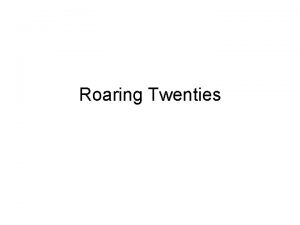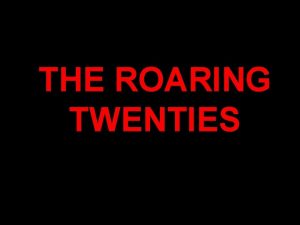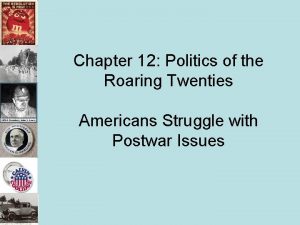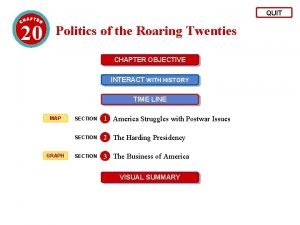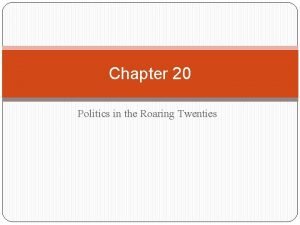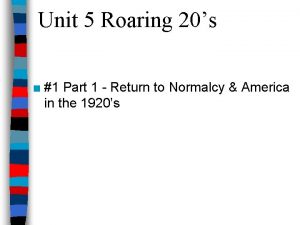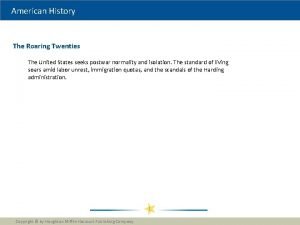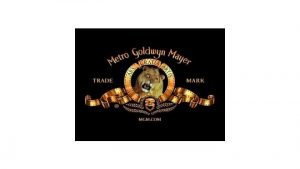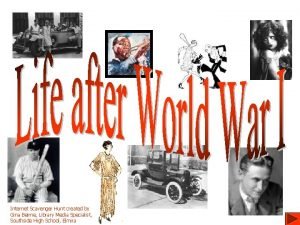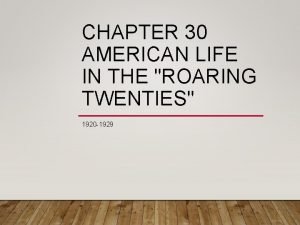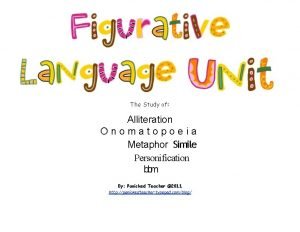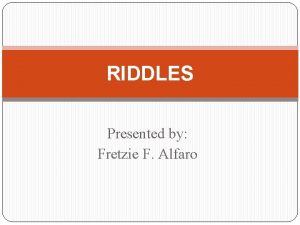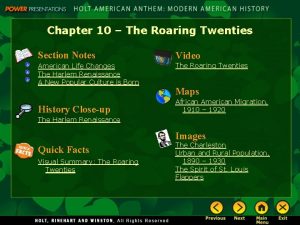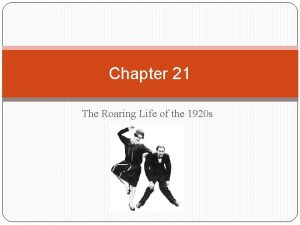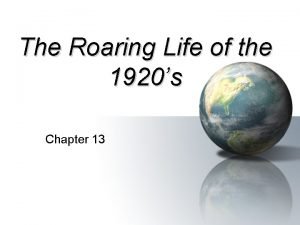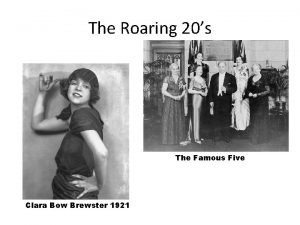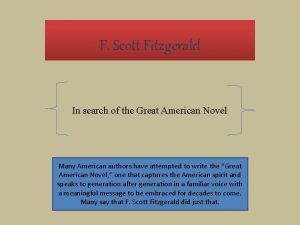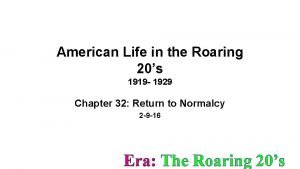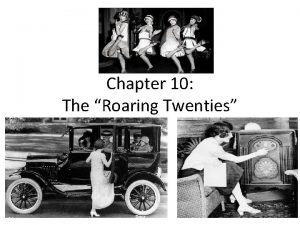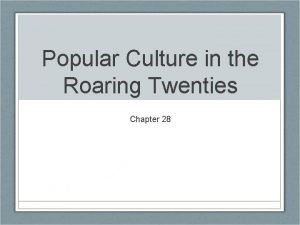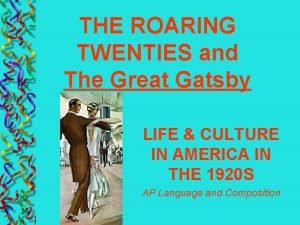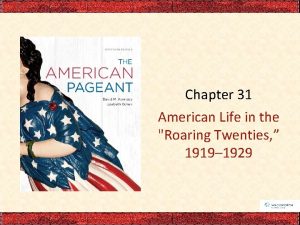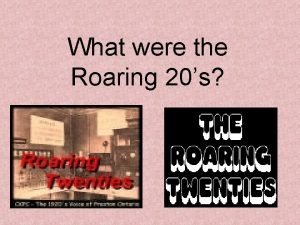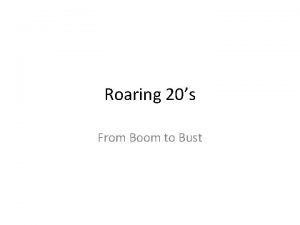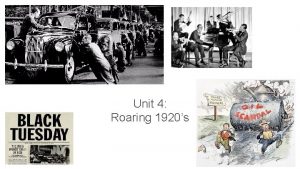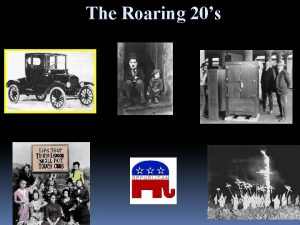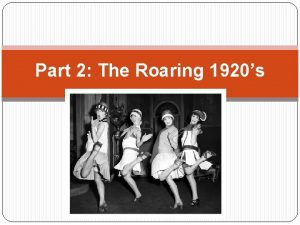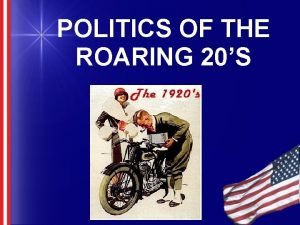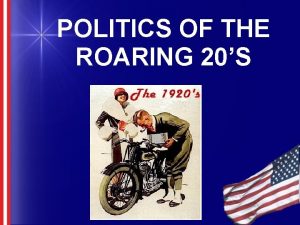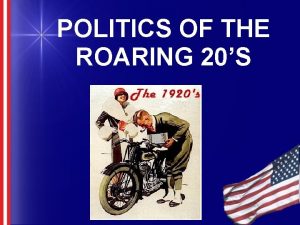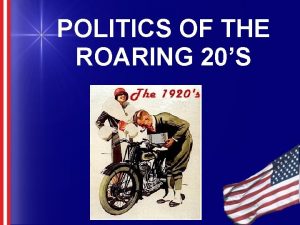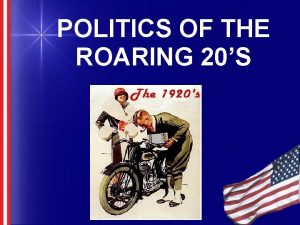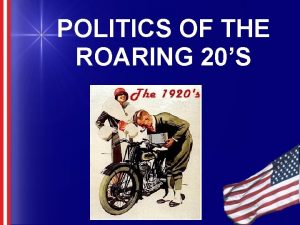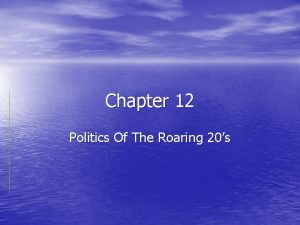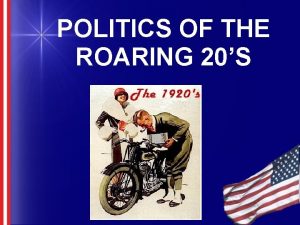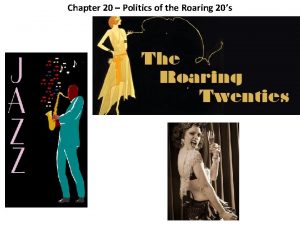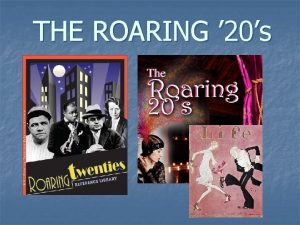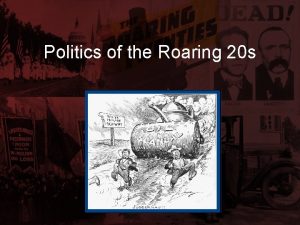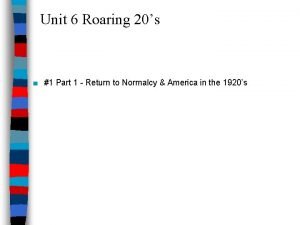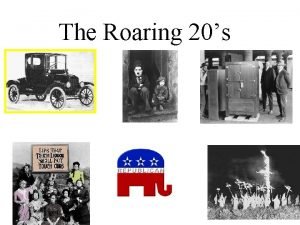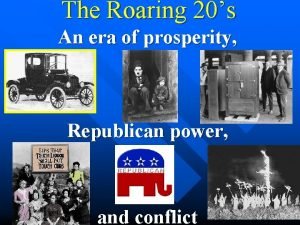POLITICS OF THE ROARING 20S Politics of the













































- Slides: 45

POLITICS OF THE ROARING 20’S

Politics of the Roaring Twenties The United States seeks postwar normality and isolation. The standard of living soars amid labor unrest, immigration quotas, and the scandals of the Harding administration. NEXT

Section 1 America Struggles with Postwar Issues A desire for normality after the war and a fear of communism and “foreigners” lead to postwar isolationism. NEXT

SECTION 1: AMERICAN POSTWAR ISSUES I. Post War Trends • The Effects of Peace on the Public A. War leaves Americans exhausted; debate over League divides them B. An economic downturn meant many faced unemployment C. Economy: cost of living doubles; farm, factory orders down 1. soldiers take jobs from women, minorities 2. farmers, factory workers suffer D. Nativism —prejudice against foreignborn people—sweeps nation E. Many Americans adopted a belief in Isolationism —pulling away from world affairs—becomes popular

II. Red Scare: FEAR OF COMMUNISM A. One perceived threat to American life was the spread of Communism B. Communism is 1. economic, political system, single-party government 2. ruled by dictator 3. no private property

SOVIET UNION COMMUNISM C. 1919 Vladimir I. Lenin, Bolsheviks, set up Communist state in Russia • He was a follower of the Marxist doctrine of social equality D. U. S. Communist Party forms; some Industrial Workers of the World join E. Bombs mailed to government, businesses; people fear Red conspiracy F. Attorney General A. Mitchell Palmer takes action Lenin

The Palmer Raids G. The Palmer Raids, J. Edgar Hoover hunt down Communists, socialists, anarchists and deported them H. Anarchists oppose any form of government I. Raids trample civil rights, fail to find evidence of conspiracy 1. without possessing search or arrest warrants; 500 were deported

ANARCHISTS • People opposed to all forms of government.

The Palmer Raids • The Palmer Raids were attempts by the United States Department of Justice to arrest and deport radical leftists, especially anarchists • Mitchell Palmer

• J. Edgar Hoover helped create and was the first director of the Federal Bureau of Investigation.

SACCO & VANZETTI 1921 J. The Red Scare fed nativism in America K. 1920, Sacco and Vanzetti, Italian immigrants, anarchists, arrested 1. charged with robbery, murder • trial does not prove guilt L. Jury finds them guilty; widespread protests in U. S. , abroad 1. Sacco, Vanzetti executed 1927

RED SCARE

III. Limiting Immigration • Anti-Immigrant Attitudes • Nativists: fewer unskilled jobs available, fewer immigrants needed • Think immigrant anarchists and socialists are Communist

THE KLAN RISES AGAIN A. As the Red Scare and anti-immigrant attitudes reached a peak the KKK was more popular than ever • By 1924, the Klan had 4. 5 million members B. Klan controls many states’ politics; violence leads to less power

CONGRESS LIMITS IMMIGRATION C. 1919– 1921, number of immigrants grows almost 600% D. Quota system sets maximum number can enter U. S. from each country 1. sharply reduces European immigration E. The Emergency Quota Act of 1921 1. Set a limit on the numbers of immigrants coming to the U. S. F. 1924, European arrivals cut to 3% of number of residents in 1890 • Discriminates against southern, eastern Europeans G Prohibits Japanese immigration; causes ill will between U. S. , Japan America changed its formally permissive immigration policy


EMERGENCY QUOTA ACT (1921) • Set a limit on the numbers of immigrants coming to the U. S. • 3% of the number of people in an ethnic group


Immigrant Restrictions Made Permanent H. National Origins Act 1924 – tightened the quota system to 2%. Goal of these were to sharply reduce European immigration into the United States. Exempts Western Hemisphere 1. Does not apply to Western Hemisphere; many Canadians, Mexicans enter 1929 - limited to 150, 000

IV. A TIME OF LABOR UNREST • Postwar Labor Issues A. Government doesn’t allow strikes in wartime; 1919 over 3, 000 strikes B. Employers against raises, unions; label strikers as Communists

BOSTON POLICE STRIKE C. Boston police strike over raises had not received a raise in years, right to unionize D. Calvin Coolidge ends strike, replaces strikers with new policemen The National Guard was called

STEEL MILL STRIKE E. 1919, steel workers strike; companies use force, refused to meet with union representatives, later negotiate • Scabs were hired while strikers were beaten by police and federal troops F. Talks deadlock; Wilson appeals; strike ends 1. 1923 report on conditions leads to 8 -hour day

COAL MINERS’ STRIKE Lewis G. 1919, John L. Lewis becomes head of United Mine Workers of America H. Leads strike November 1 ; defies court order to work; accepts arbitration = arbitrator appointed by President Wilson I. Miners receive 27% wage increase; Lewis becomes national hero

1920 s: TOUGH TIMES FOR UNIONS Ford Foundry workers in 1926; only 1% of African American workers were in Unions at the time Labor Movement Loses Appeal J. In 1920 s, union membership drops from over 5 million to 3. 5 million • Why? • African Americans were excluded from membership and immigrants were willing to work in poor conditions K. Less than 1% of African Americans, just over 3% whites in unions

SECTION 2: THE HARDING PRESIDENCY I. Harding Struggles for Peace A. International Problems B. President Warren G. Harding voices public desire for “normalcy” C. Hosts Washington Naval Conference; invites major powers, not Russia D. Sec. of State Charles Evans Hughes proposes disarmament, others agree E. In 1928 Kellog-Briand Pact nations renounce war as national policy Harding 1920 -1924

Harding Struggles for Peace High Tariffs and Reparations F. Fordney-Mc. Cumber Tariff raises taxes on U. S. imports to 60% 1. Britain, France cannot repay U. S. G. Germany defaults; Dawes Plan —U. S. investors lend reparations money 1. Britain, France repay; resentment on all sides H. DAWES PLAN - Europe was in a financial mess after World War I. Charles B. Dawes developed a plan to loan money to Germany to help the make reparations payments. I. Did little to fix economic problems in Europe NEXT


II. SCANDAL HITS HARDING Harding’s Cabinet A. Harding favors limited government role in business, social reform B. Creates Bureau of the Budget to help run government C. Has capable men in cabinet — Hughes, Herbert Hoover, Andrew Mellon D. Also appoints Ohio gang —corrupt friends who cause embarrassment • Harding does not understand all issues facing nation E. Corrupt friends use their positions to become wealthy through graft 1. caught illegally selling government supplies to private companies

TEAPOT DOME SCANDAL F. The worst case of corruption was the Teapot Dome Scandal G. The government set aside oil-rich public land in Teapot, WY H. Teapot Dome scandal — naval oil reserves used for personal gain I. Secretary of Interior Albert Fall secretly leased the land to two oil companies • Fall received $400, 000 from the oil companies and a felony conviction from the courts J. Takes bribes; is first person convicted of felony while in cabinet K. August 1923, Harding dies suddenly L. VP Calvin Coolidge assumes presidency, restores faith in government

TEAPOT DOME SCANDAL

III. DEMOCRATS AND PROGRESSIVES A. During the elections of 1920 and 1924 Democrats were divided. Warren G. Harding = Republican wins 1920 B. After Progressivism and WWI, Americans no longer wanted reform and ties to Europe. C. By the 1920 s, the United States was the dominant economic power in the world.

SECTION 3: THE BUSINESS OF AMERICA I. Coolidge’s Economic Policy A. Calvin Coolidge favors minimal government interference in business • allow private enterprise to flourish B. The new president, Calvin Coolidge, fit the pro-business spirit of the 1920 s very well • President Calvin Coolidge 1924 -1928 His famous quote: “The chief business of the American people is business. . . the man who builds a factory builds a temple – the man who works there worships there”

AMERICAN BUSINESS FLOURISHES C. LAISSEZ-FAIRE means “Hands-off. ” 1. Belief that the economy worked best when government stayed out. • • • Dominant economic belief of the 1920 s. Secretary of the Treasury for Harding, Coolidge and Hoover. Had three major goals. Balance the federal budget. Reduce government debt. Cut taxes. • Tariffs were high which helped American manufacturers • Wages were increasing

THE IMPACT OF THE AUTO The Ford Model T was the first car in America. It came only in black and sold for $290. Over 15 million were sold by 1927. D. The auto was the backbone of the American economy from 1920 through the 1970 s • It also profoundly altered the American landscape and society

IMPACT OF THE AUTO E. Cars change life—paved roads, gas stations, motels, shopping centers F. Give mobility to rural families, women, young people G. Workers live far from jobs, leads to urban sprawl (spread of cities) H. Auto industry economic base for some cities, boosts oil industry • By late 1920 s, 1 car for every 5 Americans Cities like Detroit, Flint, Akron grew

Rust Belt

Sun Belt

Wheat Belt

The Young Airplane Industry When commercial flights began, all flight attendants were female I. Airplane industry starts as mail service for U. S. Post Office J. Weather forecasting begins; planes carry radios, navigation tools K. Lockheed Company produces popular transport plane of late 1920 s K. 1927, Pan American Airways inaugurates transatlantic flights

II. MASS PRODUCTION A. Large-scale manufacturing done by machines. • Created more products and lowered prices. B. ASSEMBLY LINE • Each worker is given a specific task to complete. • Made manufacturing more efficient. 1. Used first by Henry Ford in 1913. 2. FORD MODEL T =Ford’s first assembly-line product. • By the 1920 s, Ford was selling them at $265. • Made the automobile affordable for millions.

III. AMERICAN STANDARD OF LIVING SOARS A. The years 1920 -1929 were prosperous ones for the U. S. Americans owned 40% of the world’s wealth B. The average annual income rose 35% during the 1920 s ($522 to $705) C. Discretionary income increased

ELECTRICAL CONVENIENCES While gasoline powered much of the economic boom of the 1920 s, the use of electricity also transformed the nation D. Factories use electricity to run machines E. Development of alternating current gives electricity to suburbs • By end of 1920 s, more homes begin to have electrical appliances F. Appliances make housework easier, free women for other activities G. Appliances coincide with trend of Electric refrigerators, stoves, irons, toasters, women working outside home vacuums, washing machines and sewing machines were all new

MODERN ADVERTISING EMERGES H. Advertising agencies hire psychologists to learn to appeal to public • “Say it with Flowers” slogan actually doubled sales between 1912 -1924 • Make brand names familiar nationwide; push luxuries as necessities • Businesspeople work with service groups • promote selves as benefactors of society

IV. A SUPERFICIAL PROSPERITY Producing Great Quantities of Goods A. Most Americans believe prosperity will last forever B. Productivity increasing, businesses expanding • equipment, utilities • Chain stores develop; national banks allowed to create branches • Income gap between workers, managers grows C. Iron, railroad industries not prosperous; farms suffer losses D. Wages, production, GNP, and the stock market all rose significantly

PROBLEMS ON THE HORIZON? • Businesses expanded recklessly E. Farms nationwide suffered losses due to overproduction F. Too much was bought on credit (installment plans) including stocks • Buying Goods on Credit 1. Installment plan —pay for goods over extended period with interest • Banks provide money at low interest rates G. Some economists, business owners think installment buying excessive • Think is sign of fundamental weakness behind superficial prosperity
 Demobilization and adjustment to peace 1920
Demobilization and adjustment to peace 1920 Roaring 20s fashion
Roaring 20s fashion The roaring 20s were characterized by:
The roaring 20s were characterized by: Roaring 20s vocabulary
Roaring 20s vocabulary Chapter 12 politics of the roaring twenties
Chapter 12 politics of the roaring twenties Chapter 20 politics of the roaring twenties
Chapter 20 politics of the roaring twenties Politics of the roaring twenties
Politics of the roaring twenties Chapter 20 section 2 the harding presidency
Chapter 20 section 2 the harding presidency Fashion in the 20s
Fashion in the 20s Reaction of grignard reagent with acid chloride
Reaction of grignard reagent with acid chloride The roaring twenties lesson 3 changing ways of life
The roaring twenties lesson 3 changing ways of life The roaring twenties canada
The roaring twenties canada Five effects of the great depression
Five effects of the great depression Roaring rockets powerpoint
Roaring rockets powerpoint Chapter 30 american life in the roaring twenties
Chapter 30 american life in the roaring twenties What does onomatopoeia
What does onomatopoeia Baboy sa lasang ang tunok puro lansang answer
Baboy sa lasang ang tunok puro lansang answer Chapter 10 the roaring twenties answer key
Chapter 10 the roaring twenties answer key Steamboat willie apush
Steamboat willie apush Roaring flame bunsen burner
Roaring flame bunsen burner Chapter 13 the roaring life of the 1920s
Chapter 13 the roaring life of the 1920s Roaring twenties acrostic poem
Roaring twenties acrostic poem The roaring 20’s / jazz age
The roaring 20’s / jazz age O bid me leap rather than marry paris
O bid me leap rather than marry paris Roaring twenties acrostic poem
Roaring twenties acrostic poem Chapter 10 the roaring twenties
Chapter 10 the roaring twenties Chapter 28 popular culture in the roaring twenties
Chapter 28 popular culture in the roaring twenties Roaring twenties great gatsby
Roaring twenties great gatsby Chapter 31 american life in the roaring twenties
Chapter 31 american life in the roaring twenties Các châu lục và đại dương trên thế giới
Các châu lục và đại dương trên thế giới Từ ngữ thể hiện lòng nhân hậu
Từ ngữ thể hiện lòng nhân hậu Bổ thể
Bổ thể Tư thế ngồi viết
Tư thế ngồi viết Diễn thế sinh thái là
Diễn thế sinh thái là V cc
V cc 101012 bằng
101012 bằng Thể thơ truyền thống
Thể thơ truyền thống Chúa sống lại
Chúa sống lại Sự nuôi và dạy con của hươu
Sự nuôi và dạy con của hươu đại từ thay thế
đại từ thay thế Vẽ hình chiếu vuông góc của vật thể sau
Vẽ hình chiếu vuông góc của vật thể sau Cong thức tính động năng
Cong thức tính động năng Thế nào là mạng điện lắp đặt kiểu nổi
Thế nào là mạng điện lắp đặt kiểu nổi Hát kết hợp bộ gõ cơ thể
Hát kết hợp bộ gõ cơ thể Tỉ lệ cơ thể trẻ em
Tỉ lệ cơ thể trẻ em Lời thề hippocrates
Lời thề hippocrates
